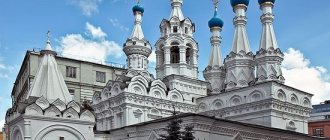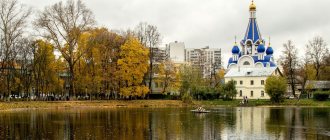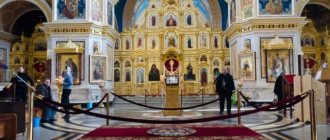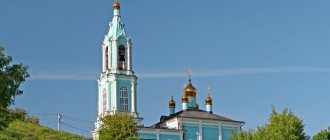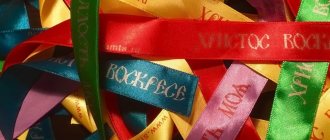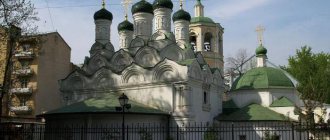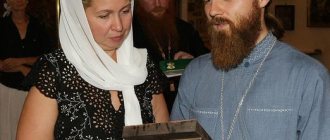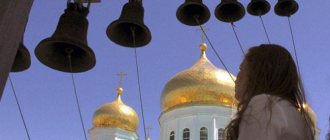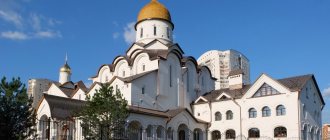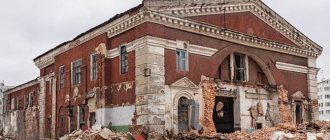The Church of the Nativity of the Virgin Mary in Putinki is one of the few tented churches that have not been destroyed to this day. It stood the test of time, the French invasion, Moscow fires and persecution by Soviet power. For more than 50 years, at the northwestern entrance to the Russian capital, the structure welcomed foreign ambassadors and travelers who stayed in the nearby embassy courtyard. Putinki was once a suburban settlement; since then Moscow has grown significantly and now the slender, elegant building perfectly adorns one of the streets of the historical center of Moscow.
Thanks to its convenient location, the church dedicated to the Nativity of Our Lady is visited by residents and guests of the Mother See on religious holidays, weekends, and simply while walking around the city center.
History of construction
The history of the temple in Putinki goes back almost four hundred years. Modern walls have survived several historical eras unchanged. Church of the Nativity of the Blessed Virgin Mary in Putinki
Temple foundation
At the beginning of the 17th century, a wooden church dedicated to the Nativity of the Virgin Mary appeared outside the Tverskaya Gate of the White City of Moscow. In the historical chronicles of this time it is called a church located “in the Ambassadorial yard in Putinki.” Experts give several versions of the appearance of this name:
- The church courtyard was located near the travel guest palace, where European ambassadors and travelers arrived on their way to the capital of the Russian state.
- Behind the gates began roads leading to different northern cities of Rus', that is, the church was located at a crossroads.
- The third version reflects the urban design features of the historical part of the main Russian city, cut through by many streets and alleys that form something like a giant web.
The wooden church, topped with three tents, burned down in the great Moscow fire of 1648. A year later, construction of a stone cathedral began in its place, most of the funds for which were allocated from the state treasury. In 1652, construction of the church was completed. It was consecrated in honor of the Nativity of the Blessed Virgin Mary.
Tsarist time
The Church of the Nativity of the Virgin Mary, located in Putinki, is the last Russian tented religious building. A year after its consecration, Patriarch Nikon banned the construction of church buildings in the tent style. The chapel of Theodore Tiron and the refectory, added at the end of the 17th century, were decorated in the Baroque style. At the same time, a gatehouse was built, from which a passage led to the bell tower. The west porch, topped by a hipped roof similar in style to the main spiers, was built in 1864. It has not survived in its original form to this day. At the end of the 19th century, the first restoration of the Nativity Church in Putinki was carried out.
Church of the Assumption of the Blessed Virgin Mary in Putinki, 1881. Interesting: believers claim that the church building survived all the shocks and fires thanks to the intercession of the Mother of God. The temple was not damaged during the capture of Moscow by the French, although all the estates surrounding it were looted and burned. After the Bolshevik revolution, the church was not immediately closed. At the end of the 20s, the brethren of the closed Vysoko-Petrovsky Monastery settled there. The doors of God's house were closed to parishioners in 1939. Office space was placed in the building, and later it was given over to the rehearsal space for the management of Circus on Stage. Animal rehearsals took place here. At the end of the 1950s, a second restoration was carried out, which affected only the external appearance of the building. In particular, the 19th century western porch was dismantled. It was replaced by a tented building, similar in style to the buildings of the 17th century. This work was recognized as an example of scientific restoration, which made it possible to preserve the ancient unique building in its original form. It’s interesting: the church, today considered an architectural monument of federal significance, was wanted to be destroyed during the Soviet years. According to legend, the explosion was scheduled for June 22, 1941. For obvious reasons, the event was cancelled. So the war prevented the Soviet government from making a fatal mistake.
Modernity
The temple was returned to the Orthodox Church in 1990. It received the status of a patriarchal metochion. The first modern rector of the church was Hegumen Seraphim. After his tragic death, the parish was headed by Archpriest Theodore Batarchukov, who is the rector of the Church of the Most Holy Theotokos in Putinki to this day.
Interior decoration of the Church of the Nativity of the Blessed Virgin Mary in Putinki By the time the building was returned to the jurisdiction of the Moscow Patriarchate, the interior decoration was almost completely lost. The church was restored using charitable funds, the famous actor Alexander Gavriilovich Abdulov provided great assistance in collecting them.
Current state
Now the temple has been restored and renovated. Its appearance corresponds to that of the late 17th century. The walls and drums of the tents are covered with plaster and whitewashed, the roof is painted dark green, and the domes are dark blue. Most of the paintings inside the church are modern, but several faces have been preserved from the 17th century. There are icons on the walls. Candlesticks are installed near them. Parishioners have access to the church through a tent-covered porch from Malaya Dmitrovka Street. The building can accommodate no more than 2,000 people at the same time.
The lighting of the interior of the temple is provided by several chandeliers, which are suspended at a height of 4-6 meters. The appearance of the Virgin Church at night is emphasized by yellow lamps installed in the windows of the bell tower and blue lanterns attached to the bases of the domes.
Organizationally, the temple is part of the Moscow Patriarchate as a parish church. The building is assigned the status of a patriarchal courtyard. Its building is included in the register of cultural heritage sites of the Russian Federation under No. 7710206000. There is a Sunday school at the church. Near the building there is a car park and a kiosk for monastery baked goods.
Architecture and interior decoration
To date, the Church of the Nativity of the Blessed Virgin Mary has been completely restored. Its external and internal decoration corresponds to the original design of the 17th century. The unique architectural monument of the 17th century is made in the style of Russian patterning, the distinctive feature of which is the use of many decorative details. The central part of the temple is a quadrangle stretching from south to north, topped with three tents that perform a decorative function. The northern aisle, dedicated to the Burning Bush icon, the patterned bell tower and the western porch are decorated with the same tents. The walls of the church are decorated on the outside with numerous decorative details. The decoration of later extensions to the building is somewhat different from its main part. It is made in the early Moscow Baroque style. The interior design of the church was practically not preserved during Soviet times. The only authentic element is the painting of the central column, depicting revered Orthodox saints. The walls of the temple are decorated with new and restored icons and paintings.
Interior of the Church of the Assumption of the Blessed Virgin Mary in Putinki Among the shrines located in the temple, the following images stand out:
- The icon of the Mother of God “The All-Tsarina” helps cancer patients -
- icon of the Mother of God “Burning Bush”, protecting from fires.
Interiors and shrines
The temple has three chapels consecrated, and its walls are decorated with beautiful ornaments. Unfortunately, the ancient decoration of the church has not been preserved. Inside there are icons by modern masters, which were painted after the temple was handed over to believers. Many of the icons were donated to the temple by parishioners.
One of the shrines of the Church of the Nativity is a rare icon in Russia of the Great Martyr Theodore Tiron.
The Christian saint lived at the turn of the 3rd-4th centuries in the city of Amasia, in Asia Minor. He was a warrior, disobeyed the orders of his commander and refused to make sacrifices to the pagan gods. Theodore Tiron had to go through prison, hunger and inhuman torture, but he continued to profess the Christian faith. In 306, the unbroken warrior was burned at the stake.
Temple opening hours
The Church of the Nativity of the Virgin Mary is located in Moscow at the address: Malaya Dmitrovka Street, possession 4. Its doors are open daily from eight in the morning to eight in the evening. Services are held on weekends and holidays at 9 a.m. and 5 p.m. Orthodox ceremonies are held in the church, a Sunday school operates, and Orthodox doctors receive consultations. In addition, temple servants provide support to disadvantaged children, orphans and prisoners. Tip: few people visit the church on weekdays, so the excursion trip should be planned on weekdays. This will allow you to calmly enjoy the interior decoration of the temple and feel its spirituality.
Useful information for pilgrims and tourists
The doors of the temple are open any day from 8:00 to 20:00. Divine services are held daily: on weekdays at 7:30, and on Sundays at 9:00 and 18:00. The church operates a children's charity fund.
Near the church fence, on Malaya Dmitrovka Street, there is a kiosk “Monastery Pastries”. There you can always buy fresh bread, fragrant rolls, cookies, cakes and rolls.
How to get there
The Church of the Nativity of the Blessed Virgin Mary is located in the historical part of Moscow. You can get to it by ground transport and by metro. By metro you need to get to the following metro stations:
- Tverskaya (green line) -
- Pushkinskaya (blue line) -
- Chekhovskaya (gray line).
Having reached the Pushkinsky cinema, you need to turn left. In a few minutes a beautiful white building will appear. The ground transport stop "Pushkinskaya Square" can be reached by buses No. H1 and A. A two-minute walk from it is the Nativity Church. The Church of the Nativity of the Blessed Virgin Mary in Putinki is a beautiful monument of Russian architecture, a striking example of the tent style that dominated Russian architecture until the end of the 17th century. It will be of interest not only to true Orthodox believers, but also to lovers of Russian history.
Church in honor of the Nativity of the Blessed Virgin Mary in Putinki This church, located at the beginning of Malaya Dmitrovka, is the last of its kind. With its construction, an entire architectural era in Russian church architecture ended, and in the 20th century it remained the only one in Moscow that was completed in the form of three tents. Construction cost local residents a very impressive amount. In this part of the street there was an Embassy Courtyard with a travel palace, where foreign ambassadors on their way to the Kremlin stayed. Hence the old name of the entire area - “Putinki”. The wooden church in the name of the Nativity of the Virgin Mary was mentioned for the first time in 1625; there is a version that even then it had a three-tent roof. In 1648 the temple burned down, a year later a new stone building was founded. Local residents, together with the clergy, through the Jerusalem Patriarch Paisius, who was then in Moscow, asked Tsar Alexei Mikhailovich for a stone for construction and money for work. The treasury allocated materials and 300 rubles. This amount was not enough, and after a second appeal the parishioners received another 400 rubles. Money was again not enough; in 1652 an additional 100 rubles were issued. As a result, the church cost 800 rubles, an unthinkable amount for the mid-17th century. But the temple was built unusual. An important architectural feature of the Church of the Nativity of the Virgin Mary in Putinki is its façadelessness: there is no one clearly defined main facade, it can be viewed from any point, it is richly decorated on all sides. Its structure is also non-trivial: the quadrangle stretches from north to south (and not from west to east), the bell tower is placed not from the west, as usual, but from the northeast, next to the three tents of the main part, placed in a row. These tents are not open from the inside, as was originally done in tent churches, but are built on top of the church vaults and serve a purely decorative function. The same can be said about the fourth tent, crowning the chapel of the Burning Bush, erected from the north in the form of a separate cube. The bases of all the drums and the tents placed on them are surrounded by large and small kokoshniks. The Church of the Nativity of the Virgin Mary was consecrated in 1652, and the very next year Patriarch Nikon banned the construction of stone tented churches in Russia, giving preference to five-domed ones. However, a small “loophole” was left for the architects: since the decree did not say anything about bell towers, they continued to be built with hipped roofs until the beginning of the 18th century. So the church on Malaya Dmitrovka became the last tented church in Moscow. At the end of the 17th century. from the southwest, the refectory with the chapel of the Great Martyr Theodore Tiron was expanded, receiving a more modest decor compared to the main part. Another change occurred in 1864, when for the visit of Emperor Alexander II from the west, a new closed porch was added, topped with a tent in the style of the main temple. In 1911, an apartment building was built from the south, partially blocking the view of the church. During the Soviet era, other Moscow churches of similar architecture from the mid-17th century. were either completely destroyed or lost their completion. The building of the Church of the Nativity of the Virgin Mary in Putinki, despite the cessation of services after 1935, was not rebuilt, preserving the decor of the facades. Only the porch was redone again during the restoration in 1957: it became open and now resembled the entrance to the chambers of the 17th century. The interior decoration was destroyed; for many years the church served as a rehearsal base for the Moscow directorate of Circus on Stage. In 1990, the temple was returned to believers; actor Alexander Abdulov provided great assistance in its restoration. It was here that his funeral service took place on January 5, 2008. The church has the status of a patriarchal metochion. In the Moscow outlying settlement, located outside the Tver Gate, a wooden church was built in the 16th century. Previously, the place was called Putinki. Now this is the area of Strastnoy Boulevard and Pushkinskaya Square. The temple was given the name of the Dormition of the Blessed Virgin Mary. The stone church was completed around 1676. At the same time, a refectory was built, and in 1690 a chapel dedicated to St. Nicholas was erected. Towards the end of the 18th century, a bell tower was added.
Fate after the revolution and during the Soviet years
From 1918 to 1938, the Church of the Nativity of the Virgin Mary was open to parishioners. Since the beginning of the 30s, religious rites and services in the building were carried out by monks of the Vysokopetrovsky Monastery. In June 1935, the ordination of monk Alexy (rector) as Bishop of Kashira took place in the church. Later this priest became the Bishop of Alma-Ata and Kazakhstan.
Services in the temple were stopped at the end of 1935. The chapel was finally closed by the Soviet authorities in Moscow in 1938. After the cessation of religious activities, the chapel building housed several offices and warehouses.
In 1957, under the leadership of architect N. N. Sveshnikov and with the participation of corresponding member of the Academy of Architecture D. P. Sukhov, restoration work was carried out in the temple. During their implementation, the porch, built in 1864, was destroyed, and in its place a new one was erected, stylized to match the period when construction of the temple began - the mid-17th century. From this porch there is access to Malaya Dmitrovka.
It is important to know : it is known that the Soviet government sought to destroy and desecrate every shrine. So, in the 70s of the last century, the building was transferred to the Moscow branch of “Circus on Stage” and until the summer of 1990 served as a rehearsal base for this organization. It was used for training with dogs.
On January 2, 1990, the transfer of the temple to the ministers of the Orthodox Church took place. In the early morning of February 2, 1991, the first abbot, 33-year-old Abbot Seraphim, was brutally killed by a blow to the head with a blunt object in his own apartment. The building was opened in August 1991 for worship, Orthodox rites and requirements.
Since the late eighties, Alexander Abdulov, a famous Russian actor, has been actively donating to the restoration of the structure . He initiated the creation and organization of the “Backyards” festival. All money raised from this event went towards renovating the building. The proceeds from the film “Backyards-3” were used to pay for reconstruction work. After the death of Alexander Abdulov, on January 5, 2008, his funeral service was held in the church, which was attended by several dozen famous actors, musicians, and singers.
History of the Assumption Church
The first mention of Putinki dates back to the 14th century . According to legend, at that time there were meadows there that were called Velikiye. Two large highways began there - to Dmitrov and Tver. In the 16th century, one of the country residences of Tsar Vasily III was located in these places. Later it was turned into a Travel Palace to stop foreign ambassadors. Presumably the name Putinki is a derivative of the word path. The fact is that it was necessary to get to the palace by paths, that is, curved alleys and streets. For the first time in chronicles, a church built of wood was mentioned in 1621. It was called the Church of the Assumption in the old Embassy Courtyard, the second name is the Church on Dmitrovka outside the city. In those days, it was famous for its icon depicting the Dormition of the Virgin Mary, exuding myrrh.
Construction of a stone temple
By the end of the 17th century, the wooden temple was either dismantled or burned down on its own. There is no precise documentary information on this matter . Under Tsar Alexei Mikhailovich in 1676, a stone church was built on the site where a wooden church had previously stood. In the 17th century, in the 90s, the first mention of the construction of a chapel in honor of St. Nicholas the Wonderworker on the northern side of the temple appears. The new chapel was made in the Moscow Baroque style. The dome of the main tower of the temple was made in the shape of an apple. This was a rather rare occurrence; there were only two such domes in Moscow. In the second half of the 18th century, the bell tower was erected. The Church of the Assumption of Our Lady gave its name to the lane on which it was located. They called him Uspensky. Later it was renamed Proezzhiy. Towards the end of the 18th century, the main development of the temple property took shape. Buildings were erected on the church graveyard in which the following were located:
- Priest.
- Deacon.
- Sexton.
- Women baking bread.
Shrines of the Church of the Assumption of the Mother of God
The church in Putinki has shrines that are revered by parishioners. There are quite a lot of icons in the small church. Among them are icons depicting:
Particularly revered icon from Constantinople
One of the faces especially revered by Christians is the icon of the Mother of God from Constantinople . One of its lists (copies) is located in the Assumption Church in Putinki. A legend has been preserved about this icon, which says that in ancient times two Greek monks from Constantinople were passing through Staraya Russa. There they served the Divine Liturgy in the cathedral church. In memory of their presence, the monks left in this church a small icon of the Mother of God, which was engraved on a slate board. This miniature face soon became famous for its miracles. After which lists were made from it, which are kept to this day in various churches in Russia, including in the Church of the Assumption in Putinki.
Repair and destruction of the Assumption Church
In 1898, an unknown benefactor donated a large amount for that time to the temple - 6 thousand rubles. This money was used to repair the building and restore the icons. The iconostasis was re-covered with gold leaf, and the walls were decorated with paintings. In 1922, the church was closed, and subsequently it was subject to partial destruction and looting. 34 spools (145 g) of gold, 6 poods and 5 pounds (100 kg) of silver and precious objects disappear from it. The domes of the temple and the bell tower were destroyed, and the entrance to it was blocked with bricks. They also destroyed the apses - buildings adjacent to the main part of the building. In their place, the door and windows were broken through. After the desecration and closure of the church, the building was used as a residential building for many years.
Reduction of territory and return to the fold of the church
Over time, the building was surrounded by extensions , which radically changed the once voluminous composition of the cathedral. The territory of the temple property was greatly reduced. They seized the northwestern part of the territory, on which a three-story house was built in 1927. Currently, it houses the embassy of the African Republic of Benin. In the second half of the twentieth century, the residential building was resettled. A sewing workshop was located there. In 1990, the temple was transferred to the Russian Orthodox Church. After this, its restoration began. In 1991, services were resumed here.
Shrines and relics of the temple
In the ancient Assumption Church there is a large collection of miraculous and revered icons.
- Myrrh-streaming icon of the Assumption of the Virgin Mary , which, according to legend, was still in the first wooden Assumption Church.
- The miraculous icon of St. Luke with a particle of relics, painted at the beginning of this century. Miracles of healing through prayer to the holy image occurred many times, as evidenced by the numerous jewelry brought by grateful believers.
- Small reliquaries are attached to the revered images of St. Panteleimon and St. Nicholas the Wonderworker.
- Icon of the holy saints Peter and Fevronia of Murom , at which a special akathist is read weekly, attracting hundreds of young free people to the temple. After their behavior, right in the temple premises, tables are set for a tea party held by the Peter and Fevronia youth club. Over the years of its existence, many lonely people have found each other.
- Revered icon of John of Kronstadt , through whose prayer healing from alcohol and drug addiction occurs. A prayer service with an akathist to the holy elder is read in the church weekly.
The “Passionate” icon of the Mother of God is especially revered, as it helps to get rid of physical ailments, emotional distress, and strengthen faith and fortitude.
Schedule of services
Temple in Putinki
The Church of the Assumption of the Virgin Mary in Putinki is located in Moscow, on Uspensky Lane, in house No. 4. The church is open to the public every day from 10:00 to 19:00, as well as during services. Information about the schedule of services in the Assumption Church is as follows:
Church of the Nativity of the Virgin Mary in Putinki
This church, located in Putinki, is truly unique. It is the only three-tent temple building on the territory of Moscow, the appearance of which has survived to this day. In 1648, the wooden temple was destroyed by fire, but on the site of the previous structure, a new one was erected from stone according to its model. Its uniqueness lies in its lack of façade, that is, from any point of view it does not have a uniformly defined façade due to the non-standard architectural solutions that were used during construction. The Church of the Nativity of the Virgin Mary is a historical architectural monument, but at the same time the temple is active and services are held in it. Service schedule:
- On weekdays, morning services begin at 7:30 am.
- On Saturday, Sunday, and also on holidays, the Divine Liturgy is held from 9-00.
- The All-Night Vigil begins at 6:00 pm.
Cathedral of the Assumption of the Mother of God in Moscow
Another Church of the Assumption of the Virgin Mary in the capital is located on the territory of the Kremlin , on the square called Cathedral. It belongs to the historical and cultural museum-reserve "Moscow Kremlin". The church was built in 1475 - 1479. The development of the project was entrusted to the famous Italian architect Aristotle Fioravanti. This temple was the main cathedral of the Russian Empire until the abolition of the monarchy in 1917. The Church of the Assumption is the oldest building in Moscow that has been completely preserved. The ashes of all the patriarchs of Moscow of the first patriarchal period, with the exception of Ignatius and Nikon, rest in the cathedral.
Interesting facts about the temple
The Assumption Church in Putinki is a place of attraction for people of creative professions.
Some of them became his generous benefactors. Peretz Boris Grebenshchikov presented the church with an icon of St. George the Victorious and an image of St. Nicholas the Wonderworker. The musician and collector of ancient icons donated the temple image of the “Assumption of the Blessed Virgin Mary,” the icon of the “Holy Trinity” and many other ancient images.
There are many more interesting facts about the temple:
Father Gleb Afanasyev asked to give him some empty church to restore, being a seriously ill man. The building on Uspensky Lane was heavily damaged and littered. For several years, the abbot and a small group of assistants cleaned the interior and surrounding area.
Only after some time did the restoration of the temple come to the attention of the capital’s authorities. The community acquired generous sponsors and helpers , whose assistance made it possible to complete the reconstruction in a short time.
Construction materials, special equipment and builders were provided by enterprises and government services (Promstroy, Moscow Department of Capital Repairs, Service Department of the Ministry of Foreign Affairs of the Russian Federation). The lighting fixtures were donated by the Sudoimport enterprise, which was located next to the temple under construction.
Description of the architecture of the temple and its brief history:
Under the tutelage of the Assumption Parish is the first Orthodox school “Peresvet”, whose students not only study the Holy Scriptures, but also learn to live according to Orthodox traditions. They pray before classes begin and attend prayer services in the Assumption Church, studying regular school subjects in the light of the Orthodox faith.
The successful experience of the association of myrrh-bearing wives prompted the organization on its basis of a special patriarchal commission, which deals with issues of assistance to retired priests and their widows. Social service in the form of coordinating her work was continued by Lyudmila Vladimirovna Afanasyeva.
From the very beginning of the revival of spiritual life, Sunday school classes have been held on the basis of the temple.
Trips to children's Orthodox camps were organized for her students. The paintings of the main temple were partially preserved under layers of paint and dirt. The restoration team managed to preserve and update the surviving fragments. Then, based on them, all their other parts were recreated.
In 2008, the construction of the Church of the Holy Royal Passion-Bearers in the Zvenigorod region was completed. The Assumption Community plans to support the restoration of the Passion Monastery, located before 1937 on Pushkinskaya Square.
The history of the origin of the Orthodox parish magazine, which appeared in 2003 in the form of a photocopied four-page leaflet, is interesting. Gradually, the church printed publication was transformed, expanding the topics of publications and increasing the volume.
The quality of the magazine improved, and by 2008 it had become a large church-wide almanac, 100 pages long.
The first capital temple made of stone
The first stone temple on this site was erected at the beginning of the 14th century, during the reign of Prince Ivan I Kalita. In the August days of 1326, in the place where the previous wooden cathedral stood, a new white-stone Assumption Church was founded. It was consecrated in 1327. The Assumption Church was the first built of stone in Moscow. Archaeological research shows that it was a single-domed temple, supported by four pillars, with triple apses. It was built in the image of St. George's Cathedral, located in the city of Yuryev-Polsky. The church was erected in an architectural style characteristic of the 14th century. The masonry consisted of squares of rough white stone. It was combined with smoothly polished decorative architectural elements. The façade of the church was crowned with kokoshniks, and the central tower was crowned with a dome.
Mentors
Very little information is known about the rectors of the Assumption Church on Putinki, who headed the parish in pre-revolutionary times.
The following names are known from surviving sources:
- O. Sergei Stenkovsky (1906-1918);
- O. John Rozhdestvensky (1918).
At the head of the parish after the return of the church to the fold of the church were three priests:
- O. Gleb Afanasyev (1992-1995);
- O. Maxim Mirov (1995-1998);
- O. Alexy Gomonov (since 1998).
The widow of Fr. is actively working to develop and strengthen the parish community. Gleba mother Lyudmila Vladimirovna Afanasyeva. She is the head of the church community and heads the society of Myrrh-Bearing Women.
Moscow Assumption Cathedral in the 15th century
During the reign of Ivan III the Great, the Moscow state gained strength. The Assumption Cathedral ceased to correspond to the status of a cathedral. The chronicles mention that it became very dilapidated and was no longer repaired. Most likely, a decision had already been made to demolish the old one and build a new stone temple. The construction of the new church, the largest in size for those years, was entrusted to the Russian architects Myshkin and Krivtsov. At the end of April 1471 the first stone was laid. However, the construction could not be completed, since on May 20, 1474, an earthquake occurred in Moscow and the cathedral collapsed. After this, Ivan III invites the Italian architect Aristotle Fioravanti, who completely dismantles what remains of the destroyed temple. At this place, under his leadership, a building is being built on the model of the Assumption Cathedral, located in Vladimir. The Assumption Church is still located on Kremlin Square. The cathedral was consecrated in August 1479, the ceremony was performed by Metropolitan Gerontius.
Laconic architecture
The temple has a laconic and monolithic appearance . The unity of the building is emphasized by the uniform division of the facades using vertical flat projections. Smooth walls are crowned with narrow arcature windows. This is the name given to the rows of decorative false arches on the façade. Apses (lower projections of a building adjacent to the main structure) are not very high. They are covered with pylons from the north and south. The pylons are a tower-like structure in the shape of a truncated pyramid. The cathedral is decorated with five large towers topped with massive domes. Aristotle Fioravanti managed to cope with the most difficult task. He increased the internal volume of the cathedral, which Myshkin and Krivtsov failed to do. The Italian, for the first time in the temple architecture of Rus', used cross vaults with a thickness of 1 brick, as well as metal openings and intra-wall connections. Essentially, he applied reinforcement.
The main idea of the Italian architect
But the main engineering and architectural idea of the Italian master was that he built additional arches behind the iconostasis . Thanks to this, the eastern halls, united by the through passages of the cathedral, in fact became a monolith. Additional arches took on a significant share of the load from the colossal towers of the cathedral. This technique made it possible to build relatively thin round pillars in the western and central parts of the temple. This gave a feeling of unusual lightness of the large structure and its integrity with the main part of the pump. The naos is the central place in the temple where parishioners are present during worship.
Rules for visiting the temple
A parishioner's clothing should be modest and closed. Women wear a skirt below the knee. The top of the outfit should have a modest neckline and cover the elbows. The parishioner's head is covered with a scarf. Men, on the contrary, take off their headdress before entering the temple, and they must also wear trousers, shirts or T-shirts (without inscriptions).
You cannot enter the holy place in shorts, open T-shirts and beach shoes.
In addition, when visiting any Orthodox church, you should follow certain rules and recommendations:
- It is necessary to arrive at the service some time in advance in order to have time to submit notes, light candles and venerate the icons. It is also necessary to take a comfortable place where the person will not impede the progress of the service.
- You should prepare in advance for visiting the temple with children. You can take them to church during your free time from the service and talk about the meaning of the actions being performed by watching a video recording of the liturgy.
- During worship, you should focus on prayer and let go of all worldly thoughts and worries. You should not greet or talk to people you know.
During communion, you should not rush or push other parishioners. They await their turn to receive the holy gifts with calmness and humility.
Moscow temple in the 15th - 16th centuries
The period from 1482 to 1515 . At this time, the initial painting of the cathedral was completed. The famous Moscow icon painter and fresco master Dionysius took part in the painting of the temple. Later, the church is redecorated, but some fragments of the original painting are preserved. They are the oldest examples of fresco painting of Rus' on the territory of the Kremlin that have survived to this day. 1574 . The Assumption Cathedral suffered from numerous fires, which occurred quite often at that time, but it was constantly restored and updated. After a severe fire in 1574, Ivan IV the Terrible issued a decree to cover the top of the cathedral with gilded copper sheets. The relics of Metropolitan Peter, kept in the church, were moved from a silver shrine to a gold one. In the same year, the crowning of Ivan the Terrible took place in the cathedral, the first in the history of the temple.
Assumption Cathedral in the 17th century
The most significant events for the temple in the 17th century were the following:
- In 1613, the Zemsky Sobor was held here, at which Mikhail Fedorovich, the first of the Romanov dynasty, was elected tsar.
- In 1624, the church vaults were worn out and threatened to collapse. To avoid this, they were disassembled and reassembled according to the modified drawing, using additional reinforcement. They also erected additional girth arches, which increased the strength of the structure.
- In 1625, the Robe of the Lord, presented to Tsar Mikhail Fedorovich by the Shah of Persia Abbas I, was transferred to the Assumption Cathedral.
Events of the 18th - 20th centuries associated with the Assumption Church
A brief chronicle of the events of this time is as follows: Currently, the Cathedral of the Assumption of the Blessed Virgin Mary operates as a museum. It can be visited any day except Thursday, from 10:00 to 18:00. While in Moscow, it is worth visiting such architectural pearls of the architecture of ancient Rus', such as churches dedicated to the Nativity and Dormition of the Mother of God. The Church of the Nativity of the Blessed Virgin Mary in Putinki was built at the turn of the 40-50s of the 17th century. The name of the architect who created the Church of the Nativity of the Blessed Virgin Mary in Putinki remains a mystery. However, it is known that the current temple arose on the site of an earlier one that was destroyed in a fire. Tsar Alexei Mikhailovich contributed to the fact that the shrine rose from the ashes. The Church of the Nativity of the Blessed Virgin Mary in Putinki became the first Russian church, one of the altars of which was consecrated in honor.
